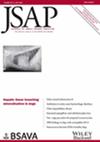Glove and instrument handling in small animal oncological surgeries: a survey
Abstract
Objectives
To evaluate veterinary surgeons' awareness of the potential for surgical gloves and instruments to act as vectors for tumour seeding in small animal oncological surgery and to assess the use of specific protocols to mitigate this risk.
Materials and Methods
A 21-question survey was developed and distributed to small animal veterinary surgeons, focusing on practices related to glove and instrument handling during oncological surgeries. The survey targeted veterinary surgeons who regularly performed oncological procedures, and was analysed using descriptive statistics and Pearson's chi-square analysis.
Results
A total of 194 veterinary surgeons participated. Most respondents (89%) reported changing gloves and instruments during oncological surgeries to avoid tumour seeding. Surgeons with advanced qualifications and those working in referral hospitals were more likely to implement these practices. Additionally, surgeons with a higher oncological caseload were more likely to follow protocols for wound protection. The majority (74%) of respondents believed that there was a risk of neoplastic cells on gloves or instruments, and 98% expressed a strong interest in evidence-based guidelines.
Clinical Significance
This study highlights a significant awareness among veterinary surgeons regarding the risk of tumour seeding through surgical gloves and instruments. There is a clear willingness among practitioners to adopt new guidelines and improve practices based on emerging evidence, indicating a potential shift towards more stringent protocols in small animal oncological surgeries.


 求助内容:
求助内容: 应助结果提醒方式:
应助结果提醒方式:


